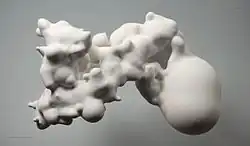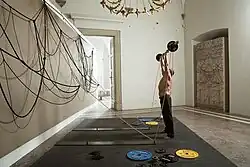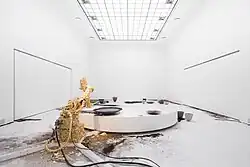Federico Díaz (artist)
Federico Díaz | |
|---|---|
Federico Díaz in 2010 | |
| Born | 18 July 1971 |
| Education | Academy of Fine Arts, Prague |
| Known for | Systems art, site-specific art, installation art, architecture, AI, robotic art |
| Notable work | Outside Itself, Geometric Death Frequency-141, Sembion, Generatrix, Sakura, Big Light, Subtile Sacramento |
Federico Díaz (born July 18, 1971[1]) is a Czech-Argentine artist. He lives and works in Prague, Czech Republic, and has exhibited at venues including the Mori Art Museum in Tokyo, CAFA Museum Beijing, Institute of Contemporary Arts London, Center for Art and Media Karlsruhe, Ars Electronica Linz, MASS MoCA, Art Basel in Miami Beach (in collaboration with MoMA PS1), the Florence Biennale, the 54th Venice Biennale, the Brno House of Arts, and the Royal Institute of British Architects. He undertook a project with the University of Cambridge and represented Czech art at the World Expo 2010 in Shanghai. From 2007 to 2014, Díaz headed the Supermedia Studio at the Academy of Arts, Architecture and Design.[2]
Díaz's work incorporates media and technologies.[3] His long-term project, "Big Light", is an ongoing series addressing the relationship between nature, humankind, and machines equipped with highly developed AI.[4]
Education and artistic career
Díaz graduated from the Academy of Fine Arts, Prague (1990–1997).[5] In 1993, he received a scholarship to Alexander Dorner Kreis. He has completed research fellowships at the Cité internationale des arts in Paris and the Soros Center for Contemporary Art (SCCA-Ljubljana).[5]
Díaz was a lecturer at Masaryk University in Brno, where he helped establish the Digital Media specialization at the Faculty of Social Studies.[6] In Prague, he founded the Supermedia Studio at the Academy of Arts, Architecture and Design (AAAD) with Rafani art group member David Kořínek.[7] He has lectured at institutions including Columbia University in New York City, Storefront for Art and Architecture, the University at Buffalo, and Gramazio & Kohler Architecture and Digital Fabrication at ETH.
Since the early 1990s, Díaz has exhibited at festivals and new media group exhibitions in Europe and Japan. His first solo exhibition was at the City Gallery Prague in 1997, followed by later exhibitions in the Czech Republic at the Moravian Gallery in Brno, Mánes Exhibition Hall, Prague Castle Riding School, the National Gallery in Prague, and the Brno House of Arts.[4]
He has also exhibited at the Institute of Contemporary Arts and Royal Institute of British Architects in London, ZKM Center for Art and Media Karlsruhe (2004), Fondation Electricité de France in Paris (2003), Ars Electronica Festival in Linz (2005), and the Mori Art Museum in Tokyo (2005). His works have been included in exhibitions at MASS MoCA in North Adams, Massachusetts (2010), the 54th Venice Biennial (2011), and a project in collaboration with the University of Cambridge (2017).[4] An SLS object from his "Resonance" project is part of the permanent collection at the FRAC Centre in Orleans, France.[8]
Work
Díaz's pro-science work integrates science and art.[9] Díaz considers science a framework for understanding the world.[10] He sees the world as a field of diverse energetic vibrations[11] and has discussed themes including human potential, opportunities for better education, and understanding among societies and people.[4]
Díaz’s installation ULTRA was featured at Art Basel Miami Beach as part of MoMA PS1’s programming. Alanna Heiss, then director of MoMA PS1, described it as “a visualization of metaphysical space” and noted Díaz’s engagement with both modernist and futuristic aesthetics.[10]
Thomas M. Messer, director emeritus of the Solomon R. Guggenheim Museum, commented: “The work of Federico Diaz may be seen in terms parallel to music, which is made up of tonalities and rhythms. In the visual arts, these elements correspond to colors and forms. Díaz’s static and kinetic elements thus combine to yield a high degree of expressiveness which, again as in the case of music, remains without representational intent.”[10]
Robotics
In 1999, Federico Díaz began developing an autonomous anthropomorphic augmented structure called “Mnemeg” that responded to visitors in the gallery space. This was an early experiment with algorithms that informed subsequent works, including "Geometric Death Frequency-141"[12] for MASS MoCA (2010) and "Outside Itself"[13] for the Venice Biennale (2011).
Díaz presented findings from these projects at the conference Digital Handwerk at the Architekturforum Zurich, organized by ETH and the studio of Gramazio & Kohler, and later at the RobArch conference in Vienna.[14]
Díaz's project "LacrimAu" at EXPO 2010 in Shanghai was a glass cubicle with a golden teardrop, designed for a single visitor. The exhibit would read the visitor's brain waves and produce a customized scent.[15]
In 2013, Díaz began experimenting with printing mechanisms as tools for creating algorithmic paintings based on audience movement patterns in the exhibition space. This technique was presented in the project "You Welded the Ornament of the Times" (2014) at the CAFA Museum in Beijing.[16]
The project "Eccentric Gravity"[17] (2015) was a site-specific architectural intervention curated by Jérôme Sans and Jen Kratochvil at Prague's Royal Belvedere Pavilion (also called Queen Anne's Summer Palace) .
Díaz's long-term project "Big Light" has been presented at the Brno House of Arts (2016) and in collaboration with the University of Cambridge (2017).[18]
Awards
From 1996 to 2002, Díaz was a finalist for the Jindřich Chalupecký Award, granted to Czech artists under 35 years of age.[19] In 2001, Díaz received a special award from the Nicola Trussardi Foundation for his work "Generatrix" at Milano Europe Futuro Presente. In 2007, Díaz received the Premio Internazionale Lorenzo il Magnifico for digital media at the Florence Biennale.[20]
Selected works and projects



- Dehibernation I, II (1993-1994) Exhibited at the Biennale of Young Art at City Gallery Prague in 1994 and at the Netz Europa exhibition in Linz, Austria.
- Spin (1994)
- Photon I, II (1996-1997)
- Empact (1998)
- Mnemeg (1999–2002)
- Generatrix (1999–2002)
- Sembion (2003–2004) Created in cooperation with the Research Centre at the Academy of Fine Arts in Prague and Jiří Ševčík, a Czech art theorist. The project has been presented at Die Algorithmische Revolution at the Center for Art and Media Karlsruhe, and the Institute of Contemporary Arts London.
- Sakura (2004–2005)
- Fluid F1 (2006)
- Efekt (2006)
- Resonance (2007)
- Ultra (2008)
- Adhesion (2009)
- LacrimAu (2010)
- Geometric Death Frequency-141 (2010) A site-specific installation for MASS MoCA in Massachusetts.[21]
- You Welded the Ornament of the Times (2014) Walls in the CAFA Art Museum in Beijing serve as canvases; an automated plotter system layers traditional ink on the surface, creating a permanent record of the activity.
- Outside Itself (2011) created specifically for the Arsenale at the Venice Biennial 2011 as part of ILLUMInations.[22]
- Eccentric Gravity (2015) utilizes the architectural features of Prague Castle's Belvedere Palace as the ground plan for a reflection on the building's history.
- Big Light (2016) The Brno House of Arts dedicated its historic International Style galleries to Díaz for an experimental laboratory and information centre.
- Big Light Space of Augmented Suggestion (2017)
- Subtile Sacramento (2017–2018)
- Big Light I'm Leaving the Body (2019)
- Eccentric Gravity: Heraldic (2015–2020)
- Aerial (Na Horu) (2018–2022), a monumental public sculpture in Prague, Czech Republic
- BOAR (2022) Part of the 12th Berlin Biennale for Contemporary Art. Commissioned by LAS. Site-specific robotic performance created with novelist and technologist, J.M. Ledgard. Utilized a SPOT, developed by Boston Dynamics, to imitate a wild boar through artificial intelligence.
- BIOTOPIA (2025) In conjunction with The Why Factory at the 19th International Architecture Exhibition of La Biennale di Venezia
References
- ^ s.r.o., Sector 31. "Federico Díaz | abart". en.isabart.org. Archived from the original on 2021-10-27. Retrieved 2025-06-26.
{{cite web}}: CS1 maint: numeric names: authors list (link) - ^ "Concrete Layers". Signal Festival. Retrieved 2025-08-01.
- ^ Heartney, Eleanor; Heiss, Alanna (2011). Federico Díaz : outside itself. Charta. ISBN 9788881588220. OCLC 781262826.
- ^ a b c d Big Light. Czech Republic. 2016. ISBN 9788070091746.
{{cite book}}: CS1 maint: location missing publisher (link) - ^ a b Various authors. Federico Díaz E AREA. Resonance. Charta Art Books, 2009.
- ^ "ne100". ne100.org. Archived from the original on 2016-06-22. Retrieved 2017-05-27.
- ^ "Vysoká škola uměleckoprůmyslová v Praze". umprum.cz. Retrieved 2017-05-27.
- ^ "Frac Centre".
- ^ Thompson, Joseph (2010). Federico Díaz : geometric death frequency 141. Charta. ISBN 9788881587933. OCLC 707609090.
- ^ a b c Resonance : Federico Díaz, E Area : visual activism, installations, architecture. Charta. 2008. ISBN 978-8881587216. OCLC 317559409.
- ^ Heiss, Alanna (2012). Federico Diaz : outside itself. Charta Art. ISBN 978-8881588220. OCLC 766343952.
- ^ Hart, Hugh. "Geometric Death Frequency Takes over Museum Courtyard". Wired.
- ^ "Federico Diaz's outside itself at the 54th Venice Biennale".
- ^ Brell-Çokcan, Sigrid; Braumann, Johannes, eds. (2013). Rob | Arch 2012. Springer. doi:10.1007/978-3-7091-1465-0. ISBN 978-3-7091-1464-3.
- ^ Pollack, Barbara (March 1, 2011), "Scents & Sensibility", ArtNews
- ^ "Federico Díaz/ The Welded Ornament of the Times". mzv.gov.cz. Retrieved 2025-03-02.
- ^ "Federico Díaz / Eccentric Gravity".
- ^ "BIG LIGHT: Federico Díaz - Announcements". e-flux. Retrieved 2025-08-01.
- ^ "Federico Diaz". cjch.cz. Retrieved 2017-05-30.
- ^ "Federico Díaz/ The Welded Ornament of the Times". mzv.gov.cz. Retrieved 2025-04-29.
- ^ Joseph Thompson, Federico Díaz, Jeffrey Kipnis, Alanna Heiss. Federico Díaz. Geometric Death Frequency –141. Charta Art Books, 2010.
- ^ Alanna Heiss, Eleanor Heartney. Outside Itself. Charta Art Books, 2011.